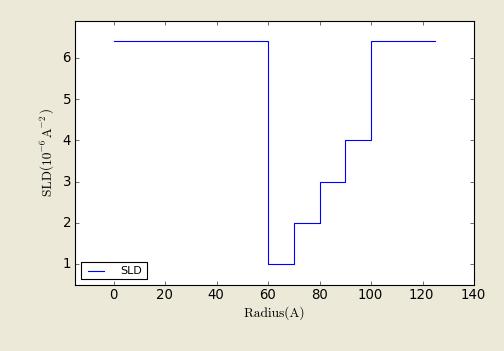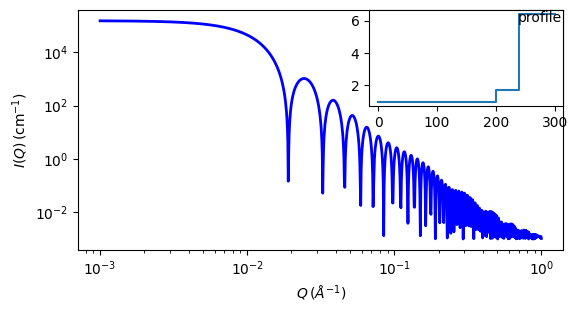core_multi_shell¶
This model provides the scattering from a spherical core with 1 to 10 concentric shell structures. The SLDs of the core and each shell are individually specified.
Parameter |
Description |
Units |
Default value |
|---|---|---|---|
scale |
Scale factor or Volume fraction |
None |
1 |
background |
Source background |
cm-1 |
0.001 |
sld_core |
Core scattering length density |
10-6Å-2 |
1 |
radius |
Radius of the core |
Å |
200 |
sld_solvent |
Solvent scattering length density |
10-6Å-2 |
6.4 |
n |
number of shells |
None |
1 |
sld[n] |
scattering length density of shell k |
10-6Å-2 |
1.7 |
thickness[n] |
Thickness of shell k |
Å |
40 |
The returned value is scaled to units of cm-1 sr-1, absolute scale.
Definition
This model is a trivial extension of the CoreShell function to a larger number of shells. The scattering length density profile for the default sld values (w/ 4 shells).

Fig. 78 SLD profile of the core_multi_shell object from the center of sphere out for the default SLDs.*¶
The 2D scattering intensity is the same as \(P(q)\) above, regardless of the orientation of the \(\vec q\) vector which is defined as
Note
Be careful! The SLDs and scale can be highly correlated. Hold as many of these parameters fixed as possible.
Note
The outer most radius (= radius + thickness) is used as the effective radius for \(S(Q)\) when \(P(Q)*S(Q)\) is applied.
For information about polarised and magnetic scattering, see the Polarisation/Magnetic Scattering documentation.
Our model uses the form factor calculations implemented in a C-library provided by the NIST Center for Neutron Research [1].

Fig. 79 1D plot corresponding to the default parameters of the model.¶
Source
core_multi_shell.py
\(\ \star\ \) core_multi_shell.c
\(\ \star\ \) sas_3j1x_x.c
References
Also see the core_shell_sphere model documentation and [2]
Authorship and Verification
Author: NIST IGOR/DANSE Date: pre 2010
Last Modified by: Paul Kienzle Date: September 12, 2016
Last Reviewed by: Paul Kienzle Date: September 12, 2016